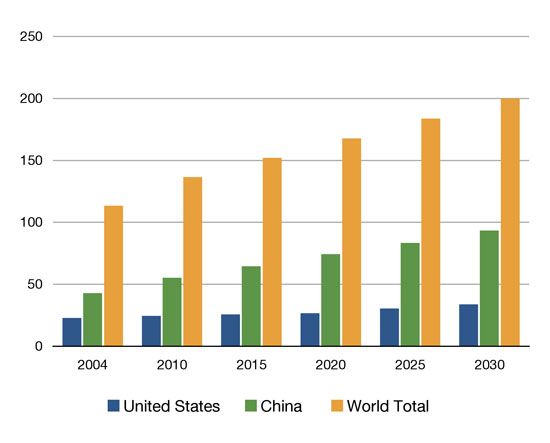As the cheapest of the fossil fuels and one of the most abundant, coal is an alluring source of energy for countries reaching for energy independence.
According to the 2007 International Energy Outlook, the U.S. Department of Energy expects world coal consumption to increase by 74 percent from 2004 to 2030, reaching 199 quadrillion Btu annually.
But coal also is the dirtiest fossil fuel. The EIA expects coal to overtake oil as the largest source of energy-related carbon-dioxide emissions by 2010, making up 43 percent of the world's emissions by 2030.
And coal has been feeling environmentalists' wrath. Among a number of other examples (see Coal Under Fire), U.S. energy titan American Electric Power last week agreed to pay $4.6 billion to install pollution controls at its coal-fired plants.
-
Where Will DOE’s Loan Program Make the Next Climate Tech Investments?
48
-
What the Frack Is Happening With Natural Gas Prices?
15
-
With an Energy Crisis Brewing, No Peak in Sight for Emissions
9
What's an energy provider to do?
One potential answer is to take the carbon dioxide and inject it deep into rock formations for long-term storage. On Thursday, the U.S. Environmental Protection Agency said it would develop regulations for the approach, called geologic sequestration.
Although taking carbon dioxide and stuffing it underground might still be years away from widespread practice, the move by the EPA has investors feeling more confident that sequestration technology will establish itself as an important player in the country's efforts to curb global warming.
Instead of releasing carbon dioxide into the atmosphere, geologic sequestration requires separating and capturing the gas from an industrial or energy-related source, transporting it to a storage location and injecting it underground.
"We believe it's going to be one of the key technologies to cut greenhouse gases," said Jason Burnett, an associate deputy administrator for the EPA. Burnett thinks the approach will help stabilize atmospheric greenhouse-gas concentrations.
But without clearly defined regulations, the energy industry has been hesitant to get started.
For example, Tampa Electric sacked plans earlier this month to build a plant that would have converted coal and other materials into a gas (see IN BRIEF: Tampa Cancels Gasification Plant). The company said the decision was based on uncertainty about potential regulations for capturing and sequestering carbon-dioxide emissions in the future.
The EPA regulations that are now in the works aim to clearly define a permit system for commercial-scale geologic-sequestration projects. The federal agency plans to propose the regulatory changes next summer.
"It's a good first step," said John Quealy, an equity analyst for Canaccord Adams. But carbon sequestration still has a ways to go before it becomes mainstream.
For starters, environmental concerns still loom, such as making sure contents underground will stay in place and not leak into drinking water.
Such fears give rise to questions about who will pay if anything does go wrong. "The question around liabilities is probably one of the premier questions about sequestration," Quealy said.
Quealy said the EPA's efforts to develop regulations could be the beginning of the framework needed to support the technology. But there are still more steps needed from economic, technical and legal bases, he said.
Despite the hurdles that lay ahead, Quealy pegs sequestration as one of the most promising technologies for carbon mitigation.
The U.S. government is also exploring its potential. On Tuesday the U.S. Department of Energy said it would dole out $197 million for three large-scale carbon-sequestration projects. Collectively, the department said the projects have the potential to store more than 100 years of carbon-dioxide emissions from all major sources in North America.
Should sequestration continue to get support, it could open the door for more coal-derived power plants to take root. Coal-fired plants are among the potential big sequestration users.
The amount of carbon dioxide spewed has always been a big hurdle for the plants, said Matt Horton, a principal at @Ventures. "If we can develop a safe and effective method of sequestration that should, in theory, allow coal-derived power to have a place at the clean-energy table," he said.
But theory and reality are two different things. After all, there are other considerations to be taken into account with coal, "like the way it is mined," Horton said.
Due to coal's polluting reputation - not to mention the potential public backlash - investors haven't been keen on backing coal plants. A prime example is the $45 billion buyout of Texan power company TXU that closed Wednesday.
The new owner is a private group of investors led by equity firms Kohlberg Kravis Roberts & Co. and TPG. In order to seal the deal with investors, the buyout group promised to cut plans to build eight of TXU's 11 proposed coal-fueled generating units.
But could investors be swayed toward coal if sequestration proves to be a safe and cost-effective way to deal with carbon dioxide? If it can be done, Horton said, "this will remove one of the biggest arguments against coal-fired plants."

